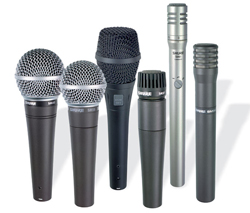
IMPEDANCE: An electrical characteristic of a microphone.
Use low-impedance microphones (under 300 ohms) to prevent hum pickup if you use mic cables over 10 feet long.
MAXIMUM SPL: The loudest sound that the mic can pick up without distorting.
A maximum SPL spec of 120 dB SPL is good, 130 dB SPL is very good, and 140 dB SPL or higher is excellent.(120 dB SPL is painfully loud.)
SELF-NOISE: A measure of how noisy the microphone is.
A self-noise spec of 25 dBA is good, 20 dBA is very good, and 15 dBA or less is excellent. A self-noise spec of 30 dB is very good if the mic is mounted directly on an instrument because the instrument’s signal is so much louder than the mic’s noise.
SIGNAL-TO-NOISE RATIO: Another measure of how noisy the microphone is.
A signal-to-noise spec of 69 dB is good, 74 dB is very good, and 79 or higher is excellent. A signal-to-noise spec of 64 dB is very good if the mic is mounted directly on an instrument because the instrument’s signal is so much louder than the mic’s noise.
POWERING: Condenser microphones require special power to operate, either a battery or phantom power.
Phantom power is 12 to 48 volts DC, and is supplied by a mixer or by a phantom power supply. Phantom power is sent to the mic on its mic cable; no extra wiring is needed.
CONNECTOR: An XLR or 3-pin pro audio connector is recommended to prevent hum pickup with mic cables over 10 feet long.
SIDE-ADDRESS: The microphone picks up best from its side. Aim the side of the mic at the sound source.
END-ADDRESS: The microphone picks up best from its end. Aim the end of the mic at the sound source.
Bruce Bartlett is a microphone engineer (www.bartlettmics.com), recording engineer, live sound engineer, and audio journalist.
